I made a version of these ribs years ago from a cookbook published in Thailand. I employed baby back ribs and posted the recipe on VWK. I liked it well enough to keep it in our grilling repertoire for a while. However, I always felt that it was missing something – a little extra complexity in the marinade, a dipping sauce of some sort.
This recipe from the Pok Pok cookbook provided an answer via a marinade that included cinnamon and nutmeg along with white pepper (the other recipe had the pepper too). As it turned out, the spices added sweet, warm depth while the tart-sweet-spicy jaew dipping sauce contributed a last minute wild layer of flavor. It was more vibrant than the previous one I'd made. We're adding this recipe to our pork rib rotation this year!
Before diving in, keep in mind a few things. There is time involved in marinating the ribs and slow cooking them, but overall, they are easy to prepare. (The jaew sauce, with its three sub-recipes are what tripped me up, but for a delicious good cause!)
Once done, the ribs are chewy-tender – the way many Asians like their meat. Savoring the richness of animal protein by lots of chewing and gnawing is a pleasure that people enjoy. Meat is traditionally a luxe ingredient, raised naturally, and consumed in modest quantities from nose to tail.
When you buy the ribs – even at a regular supermarket, ask the butcher to saw/cut them into strips for you. Asian markets often have riblets pre-cut for customers as that’s the go-to size. A rack is roughly 4 pounds (2 kg) so you can freeze half of it for later, or make a double batch.
Spice-wise, I reached for cinnamon (cassia) I bought in Vietnam, grated nutmeg by hand, and measured out Thai white pepper that Pim Techamuanvivit gifted me (the distinctive container holds chopsticks for eating noodle dishes at Pim’s new restaurant Kin Khao). You don’t have to go to such lengths but I had those particular ingredients on hand.
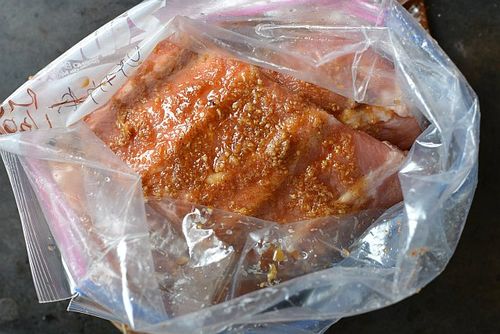
To grate the ginger, I tried a technique that Food & Wine’s test kitchen came up with – use a spoon to scrape the skin off and a fork to scrape/grate the flesh. It worked well enough, though my ginger was fibrous and a bit resistant.
See Justin Chapple of the magazine’s test kitchen demo the technique in this video. Otherwise, use a Japanese or Chinese ginger grater or a microplane. If you get some hairs like I did, they are just extra fiber for your diet. Or, as a do-over, whirl the ginger in a mini food processor with the marinade ingredients.
Andy Ricker’s original recipe encouraged charcoal grilling the ribs. He also offered an oven method, which I selected because well, it is winter. Yes, three (3) hours is the cooking time. But you can make the rest of meal and do other stuff while the ribs cook. After cooking, they can sit for an hour before cutting and eating. They reheat well too.
And if you happened to make the ribs before making the stuff for the jaew sauce, marinate the ribs overnight to buy yourself time to make the Thai staples required for the sauce. Or, plow ahead and serve the ribs just on their own. We had this as a main dish with rice and a stir-fried vegetable or salad.
Have I encouraged you enough to try out these recipes and the Pok Pok cookbook? I hope I have because they're worth the effort.
RECIPE
Thai-Style Pork Ribs
Sii Khrong Muu Yaang
Yields: 3 to 4 servings as a main dish, 6 as an appetizer
Ingredients:
- 6 tablespoons honey, a dark amber one is what I used
- 2 tablespoon regular soy sauce
- 2 tablespoons Shaoxing rice wine or dry sherry
- 1 tablespoon finely grated ginger
- ½ teaspoon toasted sesame oil
- ¼ teaspoon white pepper
- ⅛ teaspoon ground cinnamon
- A pinch of grated nutmeg
- 2 pounds (1 kg) pork spareribs, cut across the bone into 2-inch-wide strips (ask the butcher for an assist)
- ½ cup (120 ml) Jaew dipping sauce
Instructions
- In a bowl, whisk together 2 tablespoons of honey with the soy sauce, rice wine, ginger, sesame oil, pepper, cinnamon, and nutmeg. Taste and tweak, if needed, for a salty-sweet flavor. Set the marinade aside briefly.
- Put the ribs in a large zip-top plastic bag and pour over the marinade. Close the bag, expelling excess air. Rub on the bag to coat the ribs well. Set the bag flat in a baking or casserole type dish so the ribs are well exposed to the marinade. Refrigerate for 2 hours or as long as overnight. Return to room temperature before cooking.
- Before cooking the ribs, stir together the remaining 4 tablespoons of honey with 2 tablespoons of hot water. This will glaze the ribs during cooking.
- Preheat the oven to 250F (120C / gas mark ½) and line a rimmed baking sheet with foil. Put a rack on the baking sheet.
- Put the ribs on the rack and roast for 2 hours, turning midway and rotating the baking sheet if your oven is uneven. Increase the heat to 300F (150C / gas mark 2) and continue to cooking for 45 to 60 minutes, brushing on the honey every 15 minutes and flipping the ribs. When done the meat will have pulled away from the bones a bit, and be chewy-tender.
- Cool for about 10 minutes before cutting between the bones. Pile onto a plate and serve with the sauce.
Adapted from Pok Pok by Andy Ricker and J J Goode
Related posts:













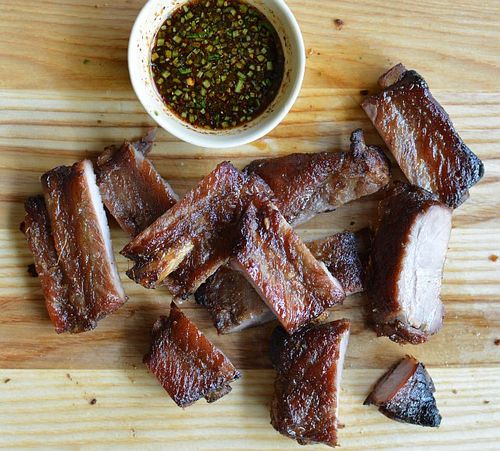
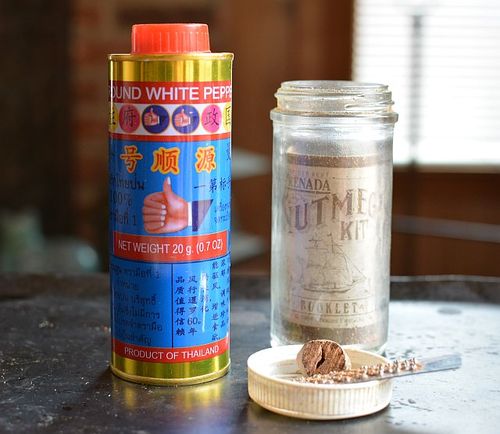
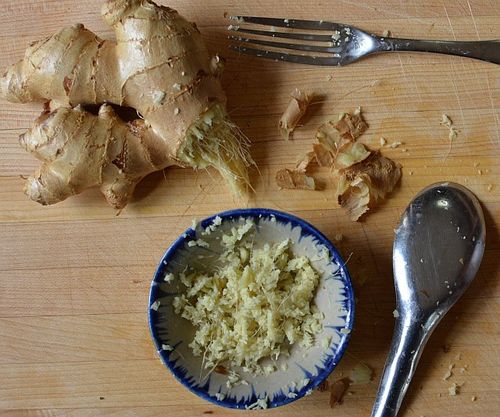

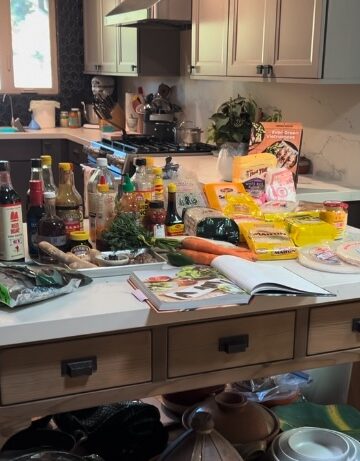


Nate @ House of Annie says
Interesting! Gonna try this one. Been looking for a few more rib recipes to play with.
Andrea Nguyen says
It's really nice, Nate. I think you and your family will enjoy it.
Joshua Hampton says
The ribs look delicious. I love the spices you used for the marinade. Gotta try it.
Lori says
I welcome any suggestions as to other types of sides to serve with this. It looks fantastic.
Andrea Nguyen says
It seems like not much but the spices make a world of difference!
Andrea Nguyen says
Regular or sticky rice would be great. So would some crisp vegetables, maybe cucumber slices. If you'd like to make a salad, check the salads in the recipe index.
http://www.vietworldkitchen.com/blog/vietnamese-recipe-index.html
If you're grilling, throw some okra on at the end. I think they'd go well with the jaew sauce. The dead-simple recipe:
http://www.vietworldkitchen.com/blog/2010/07/grilled-okra-recipe.html
Hanuman says
I am sorry but there is nothing thai about this recipe marinade. it might be American Chinese fusion or confusion. base Thai meat marinate should include the three kings: garlic, white peppercorns and coriander seeds. most people will add some soy sauce and oyster sauce along with a pinch of sugar. that's all !!! honey, ginger, Chinese cooking wine, sesame oil, nutmeg, cinnamon or any other inventions in the name of Thai cuisine might be tasty but are are simple confusion Thai cuisine
Kylene says
I am so excited to make this recipe. So funny that I found it today because the ribs are already marinading in my fridge! I picked up the cookbook this weekend and could not wait to give this particular recipe a try. I'll be posting a similar post on my website http://www.kycooksthai.net ... thanks for the insight and tips. I'll be sure to give them a try!
Andrea Nguyen says
Thanks for the insights. Would Thai whiskey stand in for the cooking wine? In "The Best of Thai Cuisine" (1987, Sangdad Publications), Sisamon Kongpan has a marinade for "barbecue pork" that includes soy sauce, sherry, sesame oil, sugar, salt, garlic plants, ginger juice and honey. This marinade is similar, though with the addition of other spices. It's nice and you should try it. If there's an argument for authenticity that you'd like to raise, I suggest you contact Andy Ricker, the author of the recipe.
Defining authenticity is a tough thing because cuisine is constantly evolving. What's important is the honesty and care that someone takes to present a particular rendition of a dish. Otherwise, you can leap down a rabbit hole and not come out.
Andrea Nguyen says
Cool, Kylene. What a coincidence! Enjoy the ribs and I look forward to your post!
Stein says
Just made this and the dipping sauce. I made a cucumber salad to go with it, Unbelievably good! I was a little surprised at the long oven time but that's what I did, planning to char them a little on my gas grill when they finished.out. But they looked so good coming out of the oven I couldn't be bothered. Incredible. And I love the extra flavor and texture the ground rice adds to the dip. Wa-HOO. Can't wait to make them again.
Now I'm thinking what a nice component to a banh mi that meat and dip might make. Can't wait for the handbook.
Hanuman says
thank you for your advice, i will get back to my hole leaving your blog behind
Mr. Adequate says
If only.
Andrea Nguyen says
You don't have to, Hanuman. Really. I like the insights and attitude that you have to contribute.
Andrea Nguyen says
Right on! Mind meld, Stein!